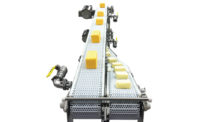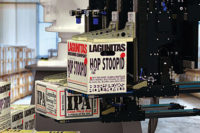Say yes to the WES
Warehouse execution systems (WES) are the missing link in the dairy cooler
A WES is a software system that combines the functionality of a WMS and a warehouse control system (WCS) into a single, integrated solution.

Gehl Foods uses Westfalia Technologies' warehouse execution system (WES), Savanna.NET, and automated storage and retrieval system (AS/RS) at its Germantown, Wis., facility.
By Fred Beer, Westfalia Technologies
Look into a typical dairy cooler and you’ll see an array of equipment – drag chain conveyors, racking, palletizers, stack pushers and more. While each piece of equipment has its own set of controls, few are linked together. Add manual materials handling processes and paper-based picking, and you have a number of moving pieces in the warehouse puzzle.
At the same time, many dairies rely on some sort of software program to help manage their inventories, whether a warehouse management system (WMS), enterprise resource planning (ERP) solution or something homegrown. Yet, these software programs are often older, and moreover, do not interface with equipment control systems, material handling components and even the labor force. Order fulfillment may still involve an operator reviewing that order (in the computer system or on paper), manually picking the products and placing them on a conveyor that feeds to the load out. In a time when order accuracy, traceability, speed and cost savings are of utmost importance, the dairy industry requires a more robust solution, like a warehouse execution system (WES).
A warehouse execution system (WES) is a software system
Fairly new, but quickly catching on across industries, a WES is a software system that combines the functionality of a WMS and a warehouse control system (WCS) into a single, integrated solution. Essentially, a WES provides the inventory management, storage optimization and traceability features of a WMS, and the automation control components of a WCS.
A WES is able to receive and track product, as it marries inventory to customer orders. When orders are received, the WES breaks them into logical units of work and then directs material handling equipment and/or manual labor to execute the work. This “two-in-one” solution drastically reduces the complexity of utilizing several different “function-specific” applications and simplifies the entire warehousing operation.
For dairy coolers, a key benefit of a WES is its flexibility. The solution can easily integrate with other systems and warehousing equipment, regardless of the amount of automation. In fact, automated systems are not required to use a WES. You can utilize just the WMS capabilities, and then “turn on” the WCS functionality when needed. This allows operators to familiarize themselves with one user interface, thereby reducing training time and expediting system start-up, if new equipment or automation is introduced as the business grows.
Allocate resources, equipment and labor better with a WES
A WES’ flexibility also allows dairies to better allocate resources, equipment and labor. This is vital, since many do not have the warehouse size to match their production and must operate within the confines of a smaller space. With real-time visibility into their equipment, inventory levels, order profiles and SKUs, operators can quickly shift priorities if equipment goes down or if there is a bottleneck in a certain area. They can also anticipate bottlenecks and production shortages, rather than reacting to these situations at the last minute. For example, if workers find that they are short a particular SKU during load out, they can easily look into the system and see how quickly they can get that SKU. Then, they can reallocate resources to the appropriate area. Or, they can send the product directly from production to load out for that particular order.
Again, automation technology is not needed to take advantage of a WES. Even if you are still using manual labor, the systems streamline worker productivity by presenting the tasks to the operator in a very succinct, meaningful manner. As a result, order fulfillment is more accurate—the right products go out the door to the right customer at the right time. Plus, the systems’ traceability functions ensure FEFO (first expired, first out) is followed.
When considering a WES, choose a modular solution
When considering a WES, the first step is to perform a thorough analysis of your operations. You may be surprised to find where you are incurring costs, perhaps from double-handling stacks and pallets, long load-out times or inaccurate inventory information. A qualified consultant or vendor with experience in dairy operations can assist in this process. Also, before implementation, be sure to clearly define your expectations and desired results. Most importantly, choose a modular solution – one that can grow with your business as you add new systems, equipment and automated technologies.
Fred Beer is the president of Westfalia Technologies, Deam Division. www.westfaliausa.com
Looking for a reprint of this article?
From high-res PDFs to custom plaques, order your copy today!








